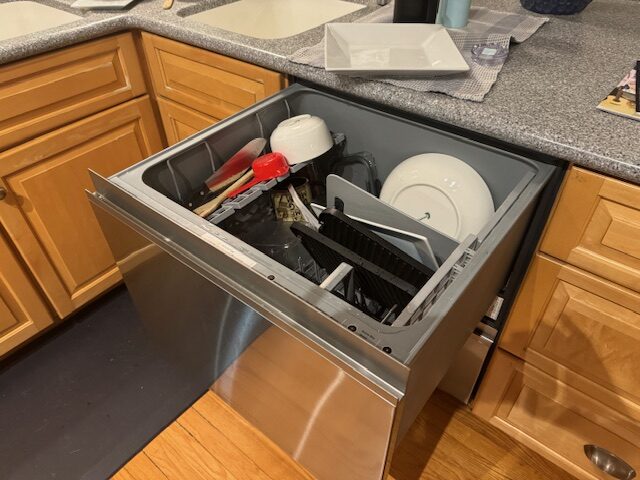
Previously we wrote an article about how modern appliances, sleek and beautiful looking with lots of fancy electronics, don’t work particularly well, and before too long, don’t work at all. Our Bosch dishwasher was called out for a special mention, because we were really tired of having to go on YouTube and listen to Joe the handyman describe how to fix the particular error code du jour. Well, we finally took that giant step for mankind and got rid of our Bosch dishwasher and all its error codes, and bought Fisher & Paykel Double DishDrawer. These two appliances are about as different from each other as it’s possible to be and still be an appliance to clean your dishes.
Interestingly, each dishwasher’s design reflects the culture of the country where it originated, regardless of where globalization has taken it for manufacturing. The Bosch dishwasher certainly reflects German culture: when loading dirty dishes you need to put everything in its proper place, and in order to pull out and then rinse the filter (the usual error code culprit) a masters degree in mechanical engineering would be handy. From the school of hard knocks we found that to have the Bosch wash our dishes without constantly kicking out an error code, we had to prewash everything (prevent those pesky grains of rice from clogging the filter), and then carefully place everything in its prescribed location–plates here, bowls there, and cups and glasses along the side, all facing inwards if possible. That, along with using the ‘speed cycle’, actually cut down on the error codes significantly, but we still got them.
The Fisher & Paykel is almost completely different. First off, there are two drawers that pull out, not one door that swings down. This allows for a lot of flexibility. If you just want to clear off some dishes but don’t have enough for a full load, just run one drawer. It’s actually handy, because you don’t have to wait to accumulate the correct amount of dirty dishes. Of course, in our case, with the amount of kids we have locally, three drawers would work for us.
Appearance-wise, we really like the Fisher & Paykel because it’s artsy. The front of both doors is stainless steel, and there are no knobs, controls or anything visible from the outside. You only see them when a drawer is open. This sleek look, combined with how quiet the Fisher & Paykel is, unfortunately has a downside. You actually can’t tell if it’s running or not without bending over and trying to listen to see if something is happening inside a drawer. This isn’t a huge problem, but it’s annoying when you go to unload and it hasn’t turned on, a problem made worse by the touch buttons inside the drawer being finicky (or us being incompetent) with the few buttons that exist).
Fisher & Paykel loading is also completely different. You can pretty much put things into the Fisher & Paykel however you like, as long as it fits. We joke that loading the Bosch was a science while loading the Fisher & Paykel is an art. It’s even sort of fun to load. And, although we did have a filter issue already, the F&P filter is easily accessible and takes only a second to clean.
All in all we really like the Fisher & Paykel, and I’m sure we’ll figure out how to properly turn it on, which is obviously an important thing to know. What’s nice, and we hope the feeling lasts, is that we really like the Fisher & Paykel, and so far it’s not at all annoying like the Bosch was.
A few quick facts:
–In true globalization fashion, Fisher & Paykel was founded and is still based in New Zealand, but is now owned by a Chinese conglomerate.
–Bosch was founded in Germany, as a joint venture between Siemens AG and Robert Bosch GmbH, and surprisingly is still owned by Bosch.
–Both brands are manufactured around the world in cheap labor companies, although Bosch actually manufactures some appliances in the US and for very high end appliances, in Germany.



